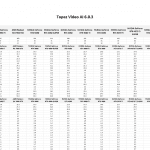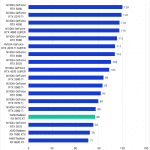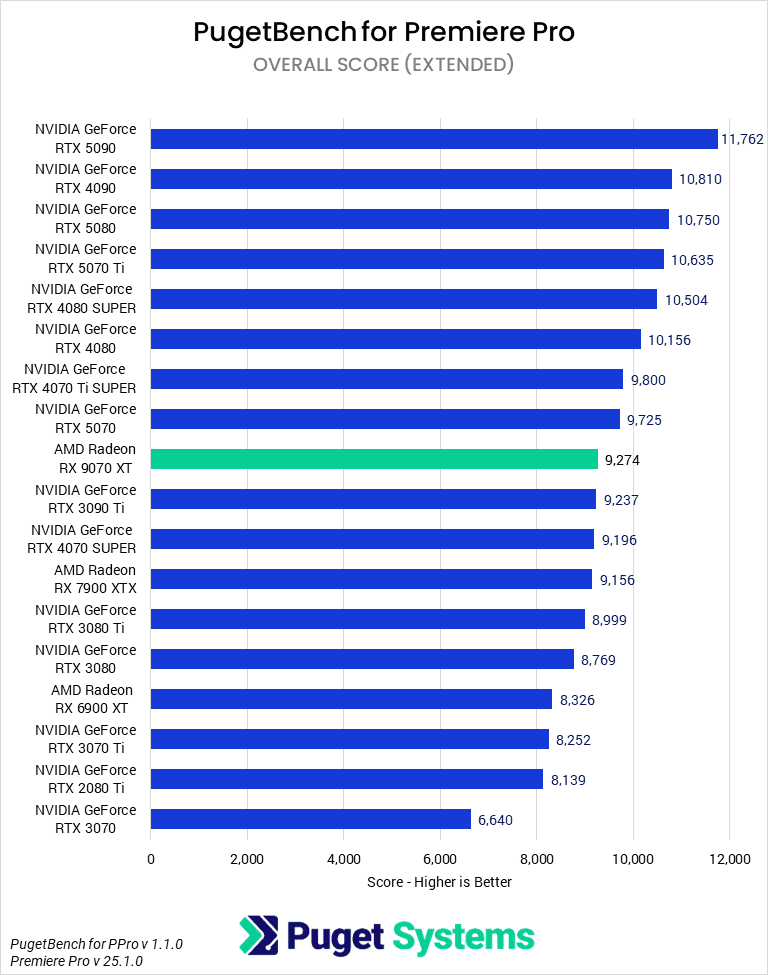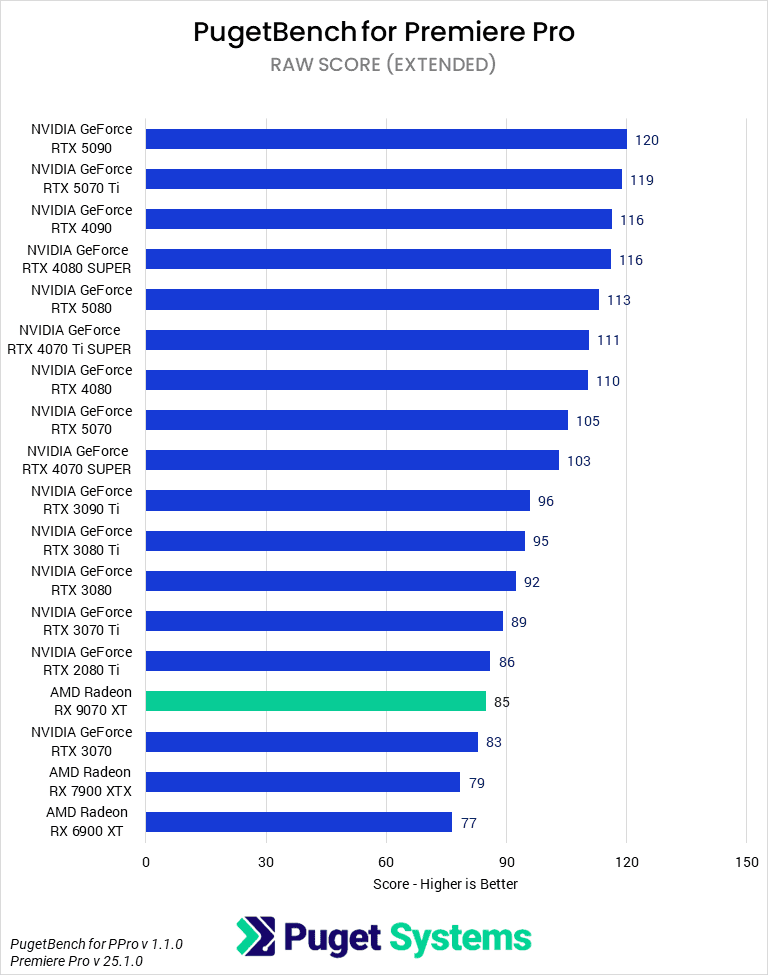Table of Contents
Introduction
Fresh off the heels of NVIDIA’s 50-series release, AMD has launched its new Radeon™ RX 9070 XT and 9070 GPUs. Based on AMD’s RDNA 4 architecture, they promise to offer competitive performance in the midrange slot, replacing the outgoing 7800 XT and 7900 GRE and competing with the NVIDIA GeForce RTX™ 5070. AMD’s big push for this generation appears to be adding, optimizing, and improving its accelerators within the GPU and further bringing its software stack to be on par with NVIDIA.
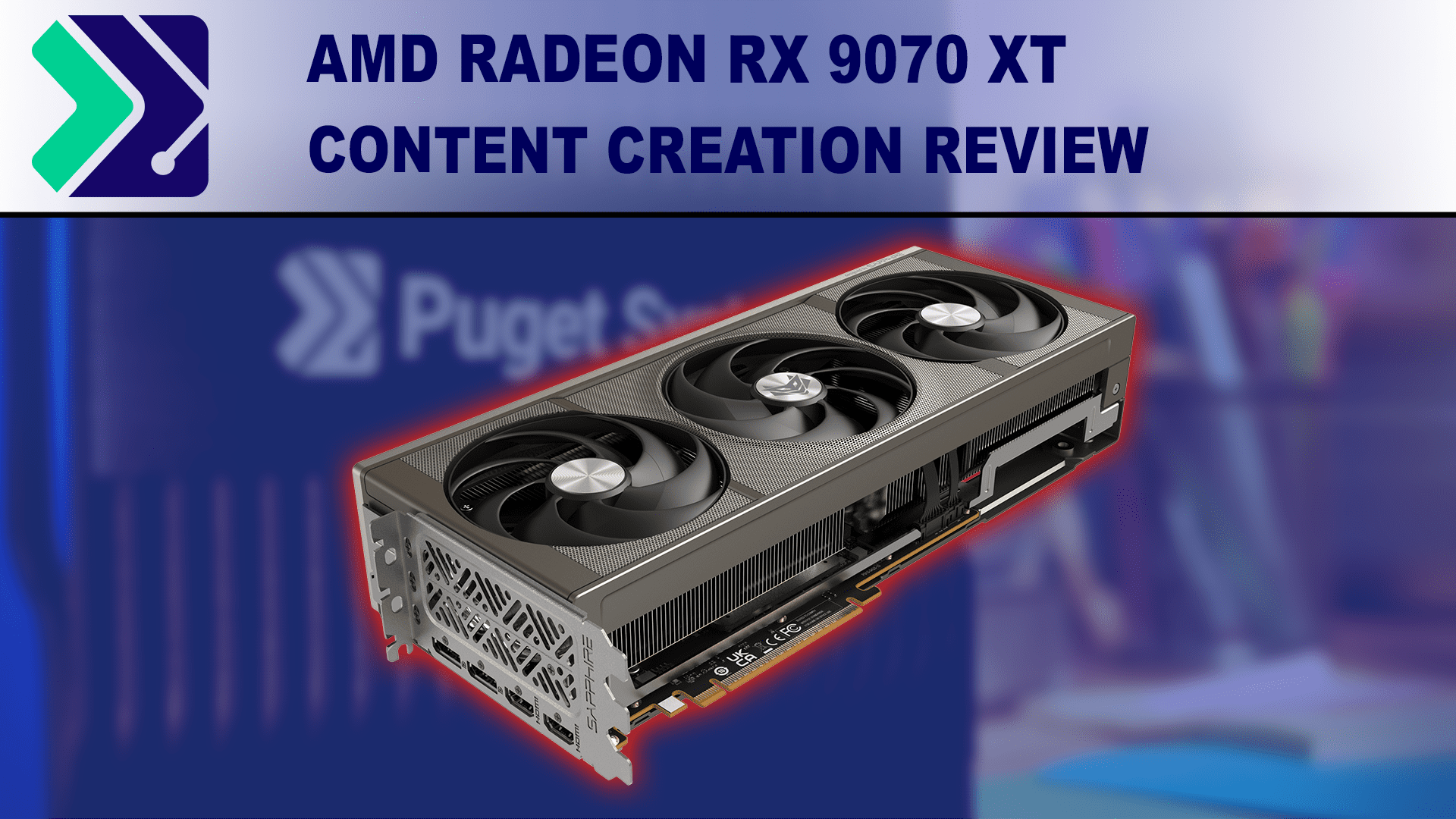
This generation, AMD has implemented a number of high-level architectural improvements that should boost performance across a variety of use cases. To start with, the AMD Radeon RX 9070 XT is based on AMD’s RDNA 4 architecture, which features a number of improvements to the memory subsystem, scalar units, and scheduler. Though less distinct from the compute unit in NVIDIA’s designs, AMD also has next-generation Ray Tracing cores, improved dual media engines, and, for the first time, dedicated matrix compute accelerators (AI accelerators).
And AMD makes bold claims about these. For Ray Tracing, it promises twice the throughput from its RT cores (though, of course, that doesn’t mean 2x the performance). The Media Engine should now support H.264 and HEVC (though we have yet to see a full list of supported “flavors” of those codecs) in addition to AV1, with improved performance and unlimited streams. For its new AI accelerators, AMD claims support of FP16 and INT8, now both with sparsity, as well as, as a first for them, FP8 formats; all told, they estimate AI performance gains of up to 8x.
AMD has also released new versions of its image-upscaling solution, FSR4, reduced-latency pipeline, Anti-Lag 2, and frame interpolation technology, Fluid Motion Frames 2.1. These are all essentially gaming-oriented, but it is good to see AMD continuing to compete with NVIDIA on not just the hardware side but also the software and feature side. Unfortunately, we will have to leave reviewing these features to other publications.
Below, we have listed the most relevant GPU specifications from AMD, Intel, and NVIDIA. For more information, visit Intel Ark, NVIDIA’s 40-series GeForce page, NVIDIA’s 50-series GeForce page, or AMD’s Radeon RX Page.
| GPU Model | MSRP | VRAM | Shader Units | Boost Clock | VRAM Bandwidth | TDP | Release Date |
|---|---|---|---|---|---|---|---|
| NVIDIA GeForce RTX 5090 | $2,000 | 32 GB | 21760 | 2.41 GHz | 1792 GB/sec | 575 W | Jan. ’25 |
| NVIDIA GeForce RTX 3090 Ti | $2,000 | 24 GB | 10752 | 1.86 GHz | 1001 GB/sec | 450 W | Jan. ’22 |
| NVIDIA GeForce RTX 4090 | $1,600 | 24 GB | 16384 | 2.52 GHz | 1001 GB/sec | 450 W | Oct. ’22 |
| NVIDIA GeForce RTX 4080 | $1,200 | 16 GB | 9728 | 2.51 GHz | 736 GB/sec | 320 W | Nov. ’22 |
| NVIDIA GeForce RTX 3080 Ti | $1,200 | 12 GB | 10240 | 1.67 GHz | 912 GB/sec | 350 W | June ’21 |
| AMD Radeon RX 7900 XTX | $1,000 | 24 GB | 6144 | 2.5 GHz | 960 GB/sec | 355 W | Dec. ’22 |
| AMD Radeon RX 6900 XT | $1,000 | 16 GB | 5120 | 2.25 GHz | 512 GB/sec | 300 W | Dec. ’20 |
| NVIDIA GeForce RTX 5080 | $1,000 | 16 GB | 10752 | 2.62 GHz | 960 GB/sec | 360 W | Jan. ’25 |
| NVIDIA GeForce RTX 4080 SUPER | $1,000 | 16 GB | 10242 | 2.55 GHz | 736 GB/sec | 320 W | Jan. ’24 |
| NVIDIA GeForce 2080 Ti | $1,000 | 11 GB | 4352 | 1.55 GHz | 616 GB/sec | 250 W | Sept. ’18 |
| NVIDIA GeForce RTX 4070 Ti SUPER | $800 | 16 GB | 8448 | 2.61 GHz | 706 GB/sec | 285 W | Jan. ’24 |
| NVIDIA GeForce RTX 5070 Ti | $750 | 16 GB | 8960 | 2.45 GHz | 896 GB/sec | 300 W | Feb. ’25 |
| AMD Radeon RX 9070 XT | $600 | 16 GB | 4096 | 2.97 GHz | 645 GB/sec | 304 W | March ’25 |
| NVIDIA GeForce RTX 4070 SUPER | $600 | 12 GB | 7168 | 2.48 GHz | 504 GB/sec | 220 W | Jan. ’24 |
| NVIDIA GeForce RTX 3070 Ti | $600 | 8 GB | 6144 | 1.77 GHz | 608 GB/sec | 290 W | May. ’21 |
| AMD Radeon RX 9070 | $550 | 16 GB | 3584 | 2.52 GHz | 645 GB/sec | 220 W | March ’25 |
| NVIDIA GeForce RTX 5070 | $550 | 12 GB | 6144 | 2.51 GHz | 672 GB/sec | 250 W | March ’25 |
| NVIDIA GeForce RTX 3070 | $500 | 8 GB | 5888 | 1.73 GHz | 448 GB/sec | 220 W | Oct. ’20 |
| Intel Arc B580 | $250 | 12 GB | 2560 | 2.67 GHz | 456 GB/sec | 190 W | Dec. ’24 |
The RX 9070 XT is unique because, for the first time since about 2020, they aren’t trying to compete with NVIDIA in the high-end market. This means that our previous points of comparison—the 7900 XTX and 6900 XT—had MSRPs well above what the 9070 XT is targeting; the 9070 XT is $600, $400 less than the 7900 XTX. Still, compared to a 9700 XTX, the 9070 XT has a 50 W lower power draw in order to run two-thirds of the shader units 500 MHz faster. In other words, it’s hard to draw meaningful comparisons. Compared to NVIDIA, the 9070 XT is $150 less than a 5070 Ti for the same amount of VRAM with 75% of the memory bandwidth at the same power draw, or $50 more than the 5070 for 4 GB more VRAM, roughly the same memory bandwidth, and 50 W higher power draw. Interestingly, AMD seems set to cannibalize one of its own GPUs this generation, as the 9070 XT and 9070 are only $50 apart, with the same memory subsystem and only a 14% difference in shader units.
Ultimately, comparing specs within a hardware generation is hard enough, let alone across architectures or manufacturers. We don’t have a great idea of how we expect the 9070 XT to perform, but a win for us would be to approach the 5070 Ti, while falling behind the 5070 would be disappointing. Additionally, AMD has touted much-improved Ray Tracing performance this generation, so we will be interested to see if they have caught up to NVIDIA, or still heavily pay the RT tax.
Test Setup
Test Platform
| CPUs: AMD Ryzen™ 9 9950X |
| CPU Cooler: Noctua NH-U12A |
| Motherboard: ASUS ProArt X670E-Creator WiFi BIOS Version: 2604 |
| RAM: 2x DDR5-5600 32GB (64 GB total) |
| PSU: Super Flower LEADEX Platinum 1600W |
| Storage: Samsung 980 Pro 2TB |
| OS: Windows 11 Pro 64-bit (26100) Power Profile: Balanced |
AMD GPUs
| AMD Radeon™ RX 9070 XT Driver: Adrenaline 25.3.1 AMD Radeon™ RX 7900 XTX AMD Radeon™ RX 6900 XT Driver: Adrenaline 24.12.1 |
NVIDIA GPUs
Benchmark Software
| Lightroom Classic 13.1 – PugetBench for Lightroom Classic 0.96 |
| Premiere Pro 25.1.0 – PugetBench for Premiere Pro 1.1.0 |
| After Effects 25.2 Beta – PugetBench for After Effects 0.98-beta |
| DaVinci Resolve 19.1 – PugetBench for DaVinci Resolve 1.1.0 |
| Topaz Video AI 6.0.3.0 |
| Unreal Engine 5.5 |
For our GPU testing, we have shifted to an AMD Ryzen 9 9950X-based platform from our traditional Threadripper platform. The 9950X has fantastic all-around performance in most of our workflows and should let the video cards be the primary limiting factor where there is the possibility of a GPU bottleneck. This means the results are more comparable to our recent Intel Arc B580 review but less so to our older GPU reviews. However, at this point in our 2025 GPU testing, we have benchmarked most of the GPUs from the last few generations, so there should be plenty of comparative data for most needs. For testing, we used the latest available GPU drivers, though as we are re-using data from our previous 50-series testing in this review, we do have a few different drivers in the mix; we have not seen large performance differences between them. We tested everything on the “balanced” Windows power profile, while Resizeable BAR and “Above 4G Decoding” were enabled for every GPU as well.
In this article, our primary focus will be the new 9070 XT. As mentioned above, at this point, we have tested all of the currently-released 50-series and most of the 40- and 30-series NVIDIA cards. Unfortunately, we are more limited in our ability to test AMD cards (as we only have the 7900 XTX and 6900 XT on hand), but we have tested those as well. We think that the 7900 GRE is probably the best overall comparison for this review, but as we did not have one to test with, the most interesting comparisons will be with the closest price-competitor in the 5070, the last-gen AMD flagship 7900 XTX, and the lowest-end 16 GB NVIDIA GPU in the 5070 Ti.
Unfortunately, despite AMD’s marketing images showing what appear to be first-party GPUs akin to what we saw with the AMD 7900 XTX reference cards, AMD has declined to release a reference version of the 9070 XT and 9070. While AIBs frequently improve on first-party designs, we like having a first-party card as we feel it gives the best representative baseline performance. Nonetheless, AMD provided us with a third-party card, the Sapphire Nitro+ AMD Radeon RX 9070 XT Gaming OC. The card is, we think, comically large, given the TDP. However, the card looks good and is quiet due to the triple-slot, triple-fan design. It has a handsome forward-facing grille with a well-diffused RBG LED bar and a solid metal construction. The most unique part of it is the backplate, which is magnetic and removable; this allows access to the power and RGB cables, which are located above the fin stack about halfway down the card, under the backplate. They then route under the backplate and come out against the motherboard to create a nearly-cable free look. We were impressed.


In terms of applications, lingering compatibility problems between the RTX 50-Series and the historic lack of support for AMD’s cards in certain rendering applications have reduced the total number of workloads we could test. Due to this, we have slightly fewer results than is typical for our GPU reviews: PugetBench for Premiere Pro, After Effects, DaVinci Resolve, Lightroom Classic, and Unreal Engine. However, we are looking into ways to increase the number of benchmarks, including rendering, for GPUs.
Raw Results Tables
We choose our benchmarks to cover many workflows and tasks to provide a balanced look at the application and its hardware interactions. However, many users have more specialized workflows. Recognizing this, we like to provide individual results for benchmarks as well. If a specific area in an application comprises most of your work, examining those results will give a more accurate understanding of the performance disparities between components. Otherwise, we recommend skipping over this section and focusing on our more in-depth analysis in the following sections. Also, we understand that having these provided in picture form is less than ideal, and we are working to improve that in future articles.
Photography: Lightroom Classic
Starting off with Pugetbench for Lightroom Classic, the AMD Radeon RX 9070 XT performs well, scoring just behind the RTX 4080 and ahead of the 5070 Ti by 2%. For those unfamiliar with our Lightroom testing, most of it isn’t GPU-accelerated, and due to some quirks of the program, our margin of error is much higher than our other benchmarks, frequently surpassing 5%. So, while the general performance of the 9070 XT is encouraging, it’s hard to say that it is definitively better than a 5070 Ti or even 5070.
One of the primary GPU-accelerated things we currently test in Lightroom is exporting photos. Our second chart examines the speed of exporting 50 JPEGs, and the 9070 XT performs relatively poorly, beating only the 3070 Ti and 3070. We experienced some issues with the 9070 XT properly enabling GPU acceleration for this task, and even once we got it working, the export times weren’t amazing. The 5070 is 12% faster than the 9070 XT, but again, this is very likely a larger discrepancy than we expect to see in practice.
Overall, we aren’t necessarily recommending the 9070 XT for Lightroom Classic. Although there are some areas (you can view all of the sub-results in the tables above) where it seemed to perform really well, there are other areas that we know to be GPU accelerated where it didn’t. We’re looking into improving our Lightroom Classic benchmark, so hopefully, we will have a more representative set of results later this year.
Video Editing: Adobe Premiere Pro
Adobe Premiere Pro sees the 9070 XT landing squarely in the middle of the chart in terms of overall score (Chart #1). It is slightly behind the 5070 (by 5%) and leads the 7900 XTX by 1%—both essentially within the margin of error. As we’ll see, though, the 9070 XT performs interestingly compared to NVIDIA’s cards in terms of where that performance (or lack thereof) comes from.
In our LongGOP tests (Chart #2), the 9070 XT is the fastest GPU we tested, beating the previous-generation 7900 XTX by 4%, the 5070 Ti by 15%, and the 5070 by 26%. This is a great showing by the card. However, we have a note of caution: Premiere Pro has yet to fully support the new media engines of NVIDIA’s Blackwell. Performance on previously accelerated formats is correct, but 4:2:2 10-bit is not yet supported in a public release. Due to that, we expect NVIDIA may close the gap or even surpass the 9070 XT overall in our LongGOP tests, though with specific variants of H.264 / HEVC media favoring either card.
Intraframe codecs (Chart #3) are traditionally unaccelerated, but the pipeline used and GPU overhead can affect performance. Here, the 9070 XT allows for the fastest Intraframe speeds we have seen on a 9950X, putting it about 10% over the 5070 and just ahead of the 7900 XTX. We wouldn’t necessarily recommend buying a 9070 XT for the Intraframe speeds, but it may be a happy coincidence if you’re looking for a more budget card.
Unfortunately, that’s where the good news for AMD ends in Premiere Pro. When working with RAW media (Chart #4), the 9070 XT falls well behind the 5070 by 19% and is 29% slower than the 5070 Ti. It does still beat the other AMD cards, including the 7900 XTX by 8%, but it’s best avoided for working with these media types. Similarly, the GPU Effects scores (Chart #5) for the 9070 XT are fairly bad. The 9070 XT is 10% slower than the 7900 XTX, 26% slower than the 5070, and 36% slower than the 5070 Ti.
Overall, whether the Radeon 9070 makes sense in Premiere Pro depends heavily on what you use the application for and what media formats you primarily work with. For LongGOP and Intraframe codecs, it can be a great choice, while for RAW formats or GPU effects, less so. We would generally caution against video editors picking up a 9070 XT for Premiere Pro until we have better data on the performance of Blackwell cards when we get full support in the near future.
Motion Graphics: Adobe After Effects
Our recent update to our After Effects benchmark has added testing for the emerging 3D workflows supported in the application. These tend to be more reliant on the GPU than the traditional 2D workflows, so we are interested to see how AMD compares, especially given that, historically, NVIDIA has been dominant in most 3D applications.
Unfortunately for AMD, the new 9070 XT is the slowest graphics card we have tested in our recent round of GPU testing. It falls behind not only the 5070 but also the 2080 Ti, 3070, and 6900 XT. We are not entirely sure what to make of this awful performance, but our recommendation for After Effects, for now, with the 9070 XT, is: just don’t. However, we are currently testing After Effects on a beta version as the 3D workflows have not yet made it to a live release, so this may change in the future; we hope AMD is able to work with Adobe to improve After Effects performance.
Video Editing / Motion Graphics: DaVinci Resolve Studio
In DaVinci Resolve, the 9070 XT is fighting an uphill battle against NVIDIA’s new NVENC and NVDEC media engines, which were made faster with Blackwell while also adding in support for a few new formats of media: H.264/HEVC 4:2:2 10-bit. Previously, this support was only available with Intel Quick Sync, and even then, only for HEVC. Unfortunately, we weren’t able to do comparisons with an Intel iGPU for this testing, but we would like to look more into that in the future. Otherwise, NVIDIA has traditionally been advantaged in GPU effects and AI workloads.
In terms of the Overall score (Chart #1), the 9070 Xt performs slightly ahead of the 7900 XTX (2%), making it notably slower than the 5070 (8%) and well behind the 5070 Ti (17%). However, more so than in many of our other comparisons, the overall score does not tell the whole story. We can start with the negatives, though. In AI workloads (Chart #7), the 9070 XT is essentially unusable, being slower than only the 6900 XT. Similarly, the 9070 XT isn’t great in GPU Effects (Chart #5), trailing the cheaper 5070 by 3% and the 7900 XTX by 8%. The 5070 Ti is even further ahead.
That’s where the bad news ends. In RAW media (Chart #4) and Intraframe media (Chart #3), the 9070 XT is solidly middle-of-the-pack. In the former, this means it is about the same as a 7900 XTX or 5070 and a bit behind the 5070 Ti. Most of these are CPU-based, though, so it will depend on the exact format you are working with. The latter is entirely CPU-based, so we are unsurprised that GPU has no effect here (though weirder things have happened).
Moving on to our LongGOP tests (Chart #2), the 9070 XT does incredibly well, falling behind only the RTX 5070 Ti, RTX 5080, and RTX 5090. In particular, it is only 11% behind the 5070 Ti (and 5080) for 20% less money. It beats the 5070 and solidly outpaces the 7900 XTX. However, we encourage those interested to check out the raw results table above, as this is very test-specific. The 9070 XT is faster than the 5080 in H.264 and H.265 encoding and just under 20% slower in H.264 / HEVC processing—except for 4:2:2 10-bit, where it is half as fast due to a lack of acceleration support. Finally, in Fusion, the 9070 XT takes the top slot by a slim margin, though many of those tests are CPU-bound.
Overall, whether a 9070 XT makes sense for DaVinci Resolve relies heavily on your specific workflow and budget. In general, an RTX 5080 or 5090 will offer better performance nearly across the board, especially in AI, GPU Effects, and some forms of LongGOP media. However, in the midrange price range, the 9070 XT stacks up well against NVIDIA in certain workflow and with certain media types, so it could make sense for certain users. It also offers a cheaper route to 16 GB of VRAM, and we are excited to look at how it pairs with Intel iGPUs in the future to try and address some of the weak spots in media acceleration.
Topaz Video AI
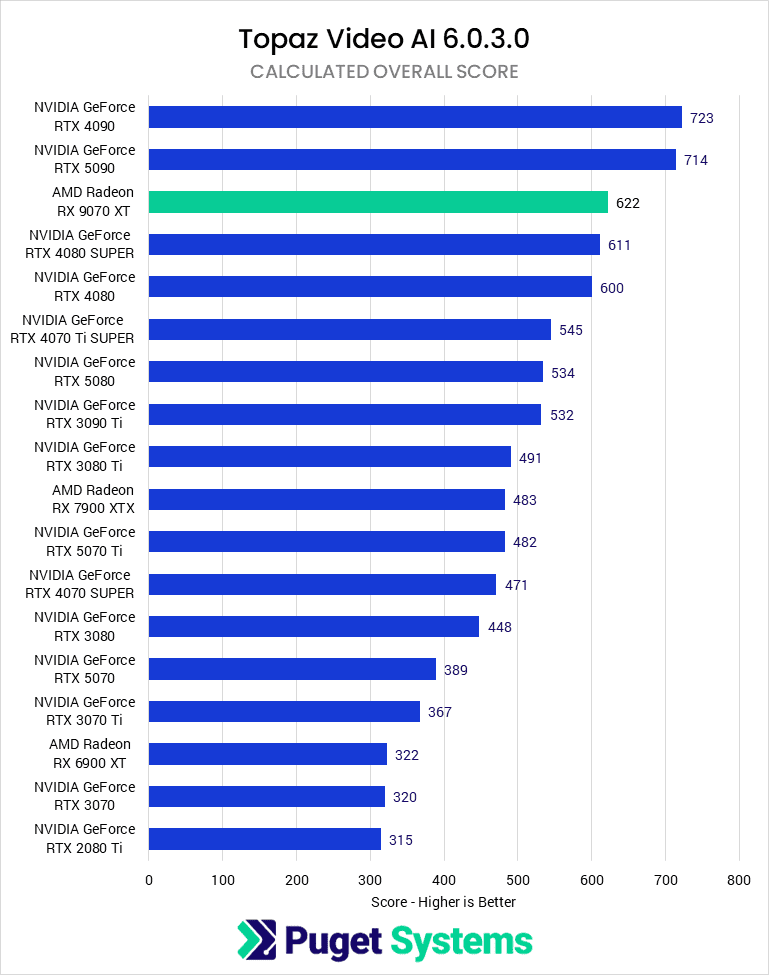
Topaz Video AI uses various AI models to upscale videos. For our testing, we run the built-in benchmark at 1080P and 4K and then take a geometric mean of the results. If you use specific models in particular, look at our results table above. Across the board, Topaz has generally favored NVIDIA with some AMD-favoring models, but it currently seems to have a performance issue with 50-series cards. There is a more recent version that we are currently testing, but for now, 40- and 50-series NVIDIA cards are functionally identical.
For AMD, the new 9070 XT performs very well. It appears as if AMD’s changes to their AI accelerators (matrix engines) are being well-utilized to improve performance in this application, and we are hopeful this will carry over into other uses. Specifically, the 9070 XT is 30% faster than the 5070 Ti and 60% faster than the 5070. Perhaps more relevantly given the weird performance issues, the 9070 XT is 29% faster than the 7900 XTX, a fantastic generational improvement putting a midrange card over the last-gen flagship. The 9070 XT still trails behind the 90-class NVIDIA cards of the last two generations but also costs half (or more!) less than then those cards. Combined with the 16 GB of VRAM, we would recommend the 9070 XT for most users of this workflow.
Game Dev / Virtual Production: Unreal Engine
Our Unreal Engine benchmark combines several scenes at varying resolutions and enabled features (e.g., Ray tracing) to see how various common factors affect GPU performance. We combine those FPS results together to get composite scores. Here, we’ve included all of our standard combinations (Ray Traced and RT, both of which include testing at all three resolutions of 4K, 1140P, and 1080P, and then each resolution individually, with both RT and Rasterized scenes included).
Looking at the Overall score (Chart #1), the 9070 XT performs well, falling behind the 5070 Ti by 7% and beating the 5070 by 18%. It is also 7% ahead of the 7900 XTX, although, as we will see, this is very dependent on the type of workload it is running. Ray Tracing (Chart #2) is, perhaps unsurprisingly, given AMD’s marketing, where the 9070 XT shines. Compared to the 5070 Ti, it falls behind by 9%, and the gap over the 5070 narrows to 15%, but it manages to beat the 7900 XTX by 13%. Obviously, AMD still loses more performance than NVIDIA in Ray Tracing and has a lower ceiling of performance, but this is a great generational uplift.
In contrast, AMD’s Rasterized performance (Chart #3) is more competitive, but less improved. In our Rasterized tests, the 9070 XT ties the 5070 Ti and the 7900 XTX, leading the 5070 by 27%. AMD has been competitive in rasterized performance for a few generations, but it is good to see the 9070 XT managing to catch up to the last-gen flagship card.
We won’t analyze each of the resolution tests individually, but in general, we see that AMD tends to perform a bit better relative to NVIDIA at lower resolutions, with the performance gap increasing as we go to 1440P and then 4K. Nonetheless, the difference isn’t huge (4.7% vs. 7.2% vs. 8.4%), and it doesn’t change the relative rankings of the cards.
In summary, the 9070 Xt is an impressive card that is highly competitive in its price segment. It offers notably better performance across the board than the 5070 (along with more VRAM) and falls just behind the 5070 Ti despite costing $150 less. While it doesn’t offer a real upgrade for those on the last-gen 7900 XTX, lower-end 7000-series users may find it compelling. We are particularly pleased with the improvements to Ray Tracing AMD has managed this generation.
GPU RENDERING – The AMD Radeon RX 9070 XT is currently supported in Blender version 4.4. As all of our current GPU testing was performed on version 4.0, we were not able to include results here. However, we hope to re-test all of our GPUs with version 4.4 in the near future as part of a GPU-roundup. In the meantime, you can check out Blender’s open database to see how it compares against some other GPUs on version 4.4.
How good is the AMD Radeon RX 9070 XT for Content Creation?
The AMD Radeon RX 9070 XT is, like most AMD GPUs, difficult to analyze for professional content creation use. In many areas, it performs well compared to its NVIDIA competition but has severe compatibility or performance issues in others. For $600 (or at least, $150 less than a 5070 Ti) it seems to generally make sense for a lot of workflows, and offers the cheapest way to get 16 GB of VRAM in a midrange card.
In video editing and motion graphics, the 9070 XT is a very mixed bag. It tends to fall behind the cheaper 5070 in heavy AI, GPU Effects, or RAW codec tests while staying very competitive with the 5070 Ti in LongGOP, Intraframe, and Resolve’s Fusion workflows. However, the exact codec is important, as NVIDIA and AMD trade blows over which LongGOP (Interframe) codec variants are accelerated and how competent that acceleration is. Unfortunately, in After Effects, the 9070 XT is largely unusable in the workloads where the GPU matters.
In rendering, AMD is, again, a mixed bag. For our real-time rendering tests in Unreal Engine, the 9070 XT was very good, falling 7% behind the 25% more expensive 5070 Ti and leading the slightly cheaper 5070 by 18%. We were particularly impressed with AMD’s improvements in Ray Tracing this generation, with the 9070 XT nearly maintaining parity with NVIDIA. NVIDIA is still better for RT but by far less than in the past. However, in our offline renderers… well, we couldn’t test any. AMD historically has far worse support in applications like Octane (unsupported), V-Ray (unsupported), Redshift (only a few newer cards are supported), and Blender (fully supported). The current Cinebench 2024 release is not compatible with the 9070 XT, and all of our testing in Blender was on version 4.0, which does not support the cards. Blender does maintain an open benchmark results database we looked at, but the results are not encouraging for the 9070 XT..
In summary, if you are interested in the 9070 XT as either a cheaper alternative to NVIDIA’s 5070 Ti or due to availability concerns, we think it can potentially be a compelling graphics card for content creation. However, make sure that you closely examine your workflow for not just which applications you use, but which parts of those applications and what type of media you most frequently work with. In many ways, choosing between a Radeon and GeForce card is much like choosing between an Intel or AMD CPU—both offer great performance, but only in certain workflows in certain applications. We are genuinely excited about these new Radeon cards and what they promise for the future competition in the GPU space for content creation.
If you need a powerful workstation to tackle the applications we’ve tested, the Puget Systems workstations on our solutions page are tailored to excel in various software packages. If you prefer to take a more hands-on approach, our custom configuration page helps you to configure a workstation that matches your exact needs. Otherwise, if you would like more guidance in configuring a workstation that aligns with your unique workflow, our knowledgeable technology consultants are here to lend their expertise.




